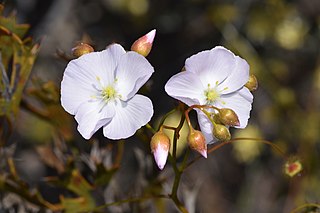
Banksia drummondii, commonly known as Drummond's dryandra, is a species of shrub that is endemic to Western Australia. It has pinnatifid to pinnatisect leaves, heads of up to one hundred cream-coloured, red and yellow flowers and glabrous fruit.
The Catalogue of Life is an online database that provides an index of known species of animals, plants, fungi, and microorganisms. It was created in 2001 as a partnership between the global Species 2000 and the American Integrated Taxonomic Information System. The Catalogue interface is available in twelve languages and is used by research scientists, citizen scientists, educators, and policy makers. The Catalogue is also used by the Biodiversity Heritage Library, the Barcode of Life Data System, Encyclopedia of Life, and the Global Biodiversity Information Facility. The Catalogue currently compiles data from 168 peer-reviewed taxonomic databases that are maintained by specialist institutions around the world. As of June 2021, the Catalogue lists 1,997,284 of the world's 2.2m extant species known to taxonomists on the planet at present time.

The plain gerygone is a species of bird in the family Acanthizidae. It is found on the islands of Wetar and Timor. Its natural habitats are subtropical or tropical moist lowland forest and subtropical or tropical mangrove forest.

The brown-breasted bamboo tyrant is a species of bird in the family Tyrannidae. It is found in Argentina and Brazil.

The yellow-browed melidectes, also known as the yellow-browed honeyeater, is a species of bird in the family Meliphagidae. It is found mainly in Papua New Guinea. Its natural habitat is subtropical or tropical moist montane forest.
Mesoperipatus is a monospecific genus of velvet worm in the Peripatidae family, containing a single species Mesoperipatus tholloni. It is found in Gabon, making it the only known species of velvet worm in the tropics of Africa, and the only known species of peripatid velvet worm in Africa. Females of this species have 24 to 27 pairs of legs; males have 23 or 24.

Acacia drummondii, commonly known as Drummond's wattle, is a perennial shrub endemic to Western Australia.
Maingaya is a monotypic genus of plant containing the sole species Maingaya malayana. It is a tree endemic to Peninsular Malaysia. It is threatened by habitat loss.
Tarenna agumbensis is a species of plant in the family Rubiaceae. It is endemic to Karnataka in India.

Tarenna is a genus of flowering plants in the family Rubiaceae. There are about 192 species distributed across the tropical world, from Africa, Asia, Australia to the Pacific Islands. They are shrubs or trees with oppositely arranged leaves and terminal arrays of whitish, greenish, or yellowish flowers.
Tarenna luhomeroensis is a species of plant in the family Rubiaceae. It is endemic to Tanzania.
Tarenna monosperma is a species of plant in the family Rubiaceae. It is native to Kerala and Tamil Nadu in India.

Tarenna nilagirica is a species of plant in the family Rubiaceae. It is native to Karnataka and Kerala in India.
Tarenna quadrangularis is a species of plant in the family Rubiaceae. It is endemic to Tanzania.

Cornus drummondii, commonly known as the roughleaf dogwood, is a small deciduous tree that is native primarily to the Great Plains and Midwestern regions of the United States. It is also found around the Mississippi River. It is uncommon in the wild, and is mostly found around forest borders. The roughleaf dogwood is used as a buffer strip around parking lots, in the median of highways and near the decks and patios of homes. It can grow to a height of 15 to 25 feet with a spread of 10 to 15 feet. The roughleaf dogwood flowers during the summer months. It produces near-white four-petaled flowers that are followed by small white fruits, which ripen from August to October. These dogwoods can form a dense thicket that is used as cover for wildlife. Over forty species of birds are known to feed on the fruits.

Drosera drummondii is a plant in the family Droseraceae, native to Western Australia.

The World Database on Protected Areas (WDPA) is the largest assembly of data on the world's terrestrial and marine protected areas, containing more than 260,000 protected areas as of August 2020, with records covering 245 countries and territories throughout the world. The WDPA is a joint venture between the United Nations Environment Programme World Conservation Monitoring Centre and the International Union for Conservation of Nature World Commission on Protected Areas.

The biodiversity of Colombia is the variety of indigenous organisms in the country with the second-highest biodiversity in the world, behind Brazil. As of 2021, around 63,000 species are registered in Colombia, of which 14% are endemic. The country occupies worldwide the first position in number of orchids, birds and butterflies, second position in plants, amphibians and fresh water fish, third place in species of palm trees and reptiles and globally holds the sixth position in biodiversity of mammals.

Xanthorrhoea drummondii, commonly known as blackboy, grasstree or Drummond's balga, is a species of grasstree of the genus Xanthorrhoea native to Western Australia.

Spatalla longifolia, the pink-stalked spoon, is a flower-bearing shrub that belongs to the genus Spatalla. It forms a part of the fynbos. The plant is native to the Western Cape where it is found in the Hottentots-Holland Mountains; from Franschhoek and Villiersdorp to the Kleinmond Mountains.













